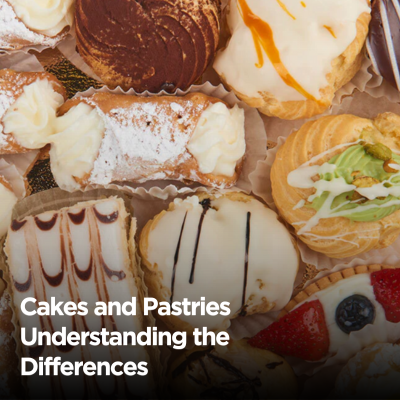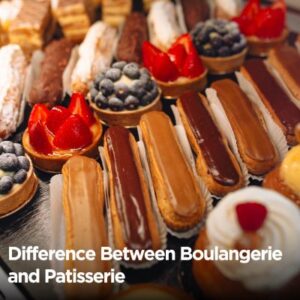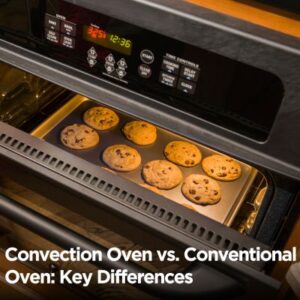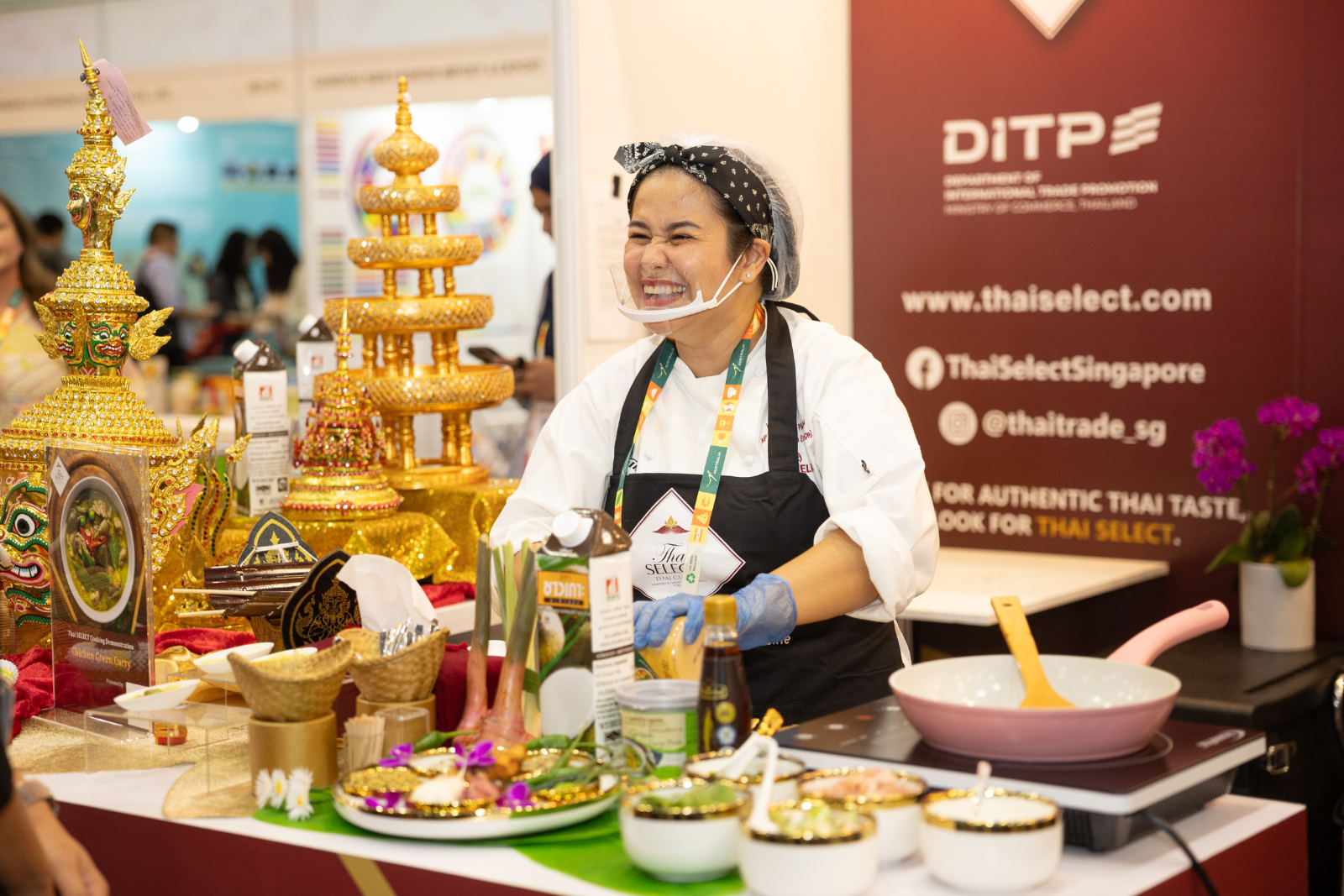On every occasion, cakes and pastries secure a prominent place on the table, making them popular among the masses. As of 2024, the global cakes and pastries market size was standing at $146 Billion. But are both cakes and pastries the same as most people think?
For someone unaware of the baking industry, it’s difficult to differentiate between cakes vs. pastries, especially when sliced and served. Their golden crusts, soft interiors, and decorative toppings can make them look alike.
However, beyond their size, they are fundamentally different. While cakes are typically light, fluffy, and layered with frosting, pastries have a more structured, flaky, or crisp texture.
The distinction goes beyond texture and size; each has a unique recipe requiring different techniques and skill sets to perfect. According to baking experts, the primary difference between pastries and cakes originates from their ingredients and preparation methods.
Read this blog to explore the key differences between cakes and pastries, from their ingredients to their ideal occasions for consumption.
Differences Between Cakes and Pastries
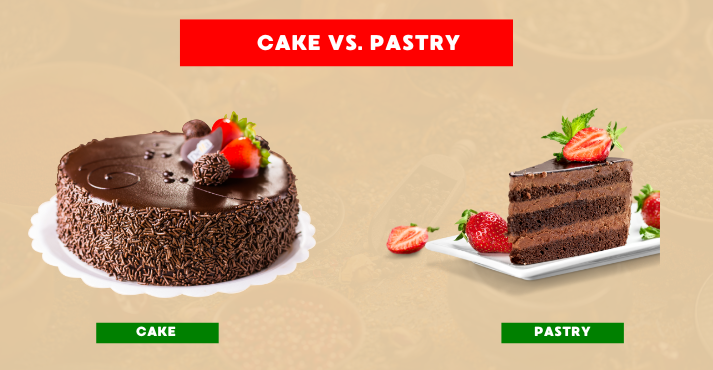
Understanding these differences in cakes vs. pastries is essential, especially for baking professionals and dessert lovers who want to explore the art behind each baked item.
For those looking to explore the latest trends, techniques, and innovations in the world of baking and desserts, the Bakery & Pastry Trade Show is a must-visit event.
Whether you are celebrating a special occasion with a beautifully decorated cake, enjoying a quick pastry with your morning coffee, or a baking expert getting ready to set up your bakery or patisserie, knowing what sets them apart is crucial either way (as a consumer or a producer).
| Aspect | Cakes | Pastries |
|---|---|---|
| Ingredients | Flour, sugar, eggs, butter, milk, leavening agents, flavorings | Flour, butter, water; sometimes eggs, sugar, or salt |
| Preparation | Mixed into a batter and baked until fluffy | The dough is rolled, folded, or laminated for a flaky texture |
| Texture | Soft, moist, and airy | Crisp, flaky, or light, depending on the type |
| Shapes & Sizes | Round, rectangular, layered, multi-tiered | Smaller, often uniform shapes like tarts, croissants, or turnovers |
| Flavors | Sweet flavors with icing, frosting, or glazes | It can be sweet or savory, often filled with fruit, custard, or cheese |
| Occasions | Common in celebrations like birthdays and weddings | Typically enjoyed as a snack or breakfast item |
Let’s explore the origins in detail to see where all the difference between pastries and cakes comes from.
Ingredients Used
According to baking experts, the main distinction between cakes vs. pastries arises from their ingredients, followed by preparation methods they master in their hospitality training and baking workshops.
Cakes
Cakes are made using a combination of flour, sugar, eggs, butter, and leavening agents such as baking powder or baking soda. These ingredients work together to create a soft, airy texture. In many cake recipes, milk or other liquid ingredients are also included to add moisture.
Flavoring agents like vanilla extract, cocoa powder, or fruit purees are also used to enhance the taste. Once baked, cakes are typically topped with icing, frosting, or glazes to improve their appearance and flavor.
Pastries
Pastries require fewer ingredients. The essential components include flour, butter, and water. Some recipes may call for eggs or a small amount of sugar or salt, but the foundation of pastry dough remains simple.
Unlike cakes, pastries do not rely on leavening agents like baking powder. Instead, their structure comes from how the dough is handled and baked. The high-fat content, usually from butter, gives pastries their distinct flaky or crisp texture.
Preparation Methods
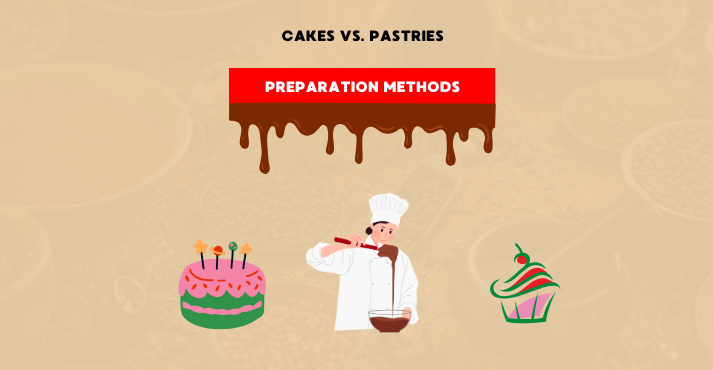
The preparation method is the second critical aspect that differentiates pastries from cakes. There are two different methods that remain instrumental at this differentiating point.
- Creaming (in cakes)
- Lamination (in pastries)
Cakes
Cakes require a specific mixing process to ensure they rise properly during baking. The ingredients are usually combined using a creaming method: mixing butter and sugar before adding eggs and dry ingredients.
Some cakes, such as sponge cakes, require whipping eggs to incorporate air, which helps the cake rise. The batter is then poured into a cake tin and baked at a controlled temperature. Once baked, the cake needs to cool before applying icing or decorations.
Pastries
Pastries involve a different preparation technique. Rather than mixing the ingredients into a smooth batter, pastry dough passes through the lamination process: rolling and folding multiple times to create layers.
Lamination is essential for certain pastries like puff pastry and croissants. Some pastries, like shortcrust pastry, require minimal handling to prevent the butter from melting too quickly.
The dough is often chilled before baking to maintain its structure. Once placed in the oven, the layers separate due to the steam released from the butter, creating a light, flaky texture.
Texture
This difference results from different ingredients and preparation methods used for cakes vs pastries.
Cakes
Cakes are known for their soft, spongy, and moist texture. Combining eggs, butter, and leavening agents allows cakes to rise, creating an airy structure.
The crumb of a cake varies depending on the recipe (some cakes are dense, like pound cakes, while others are light and fluffy, like chiffon cakes).
Adding frostings, syrups, or fillings can enhance the texture, making each bite rich and flavorful.
Pastries
Due to their high-fat content and method of preparation, pastries have a crisp or flaky texture. Pastries develop layers through folding and rolling, unlike cakes, which rely on aeration for their structure. This results in a delicate crunch when baked.
Some pastries, like Danish pastries and croissants, have a soft interior but maintain a crisp outer layer. Others, like puff or filo pastry, are entirely flaky and light.
Shapes and Sizes
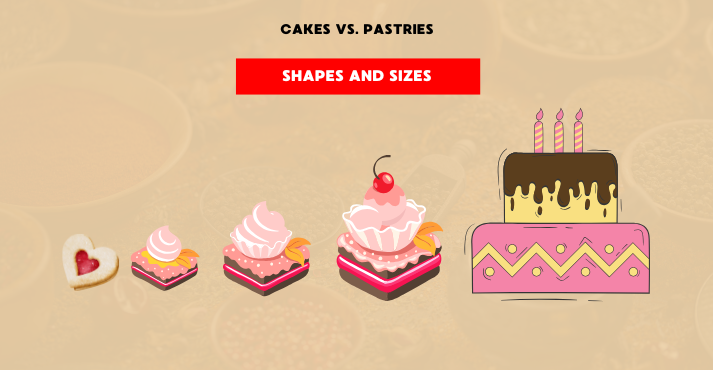
For a layman who knows nothing about ingredients and preparation methods, this is the ideal differentiator between pastry and cake.
Cakes
Cakes are available in a variety of shapes and sizes. They are commonly baked in round or rectangular tins but can also be found in square, heart-shaped, or even custom molds for special occasions.
You’ve probably attended a passing-out party for a lawyer or doctor friend (or else), where the cake was designed to resemble their professional attire.
Cakes may have multiple layers held together by frosting or fillings. Depending on the purpose, cakes range from single-serving cupcakes to large, multi-tiered (multiple stories like buildings, separated with pillars) wedding cakes designed to serve many people.
Pastries
Pastries are usually more miniature versions of cake and come in distinct shapes. Common forms include triangular turnovers, circular tarts, and rectangular strudels.
Pastries are often made in single-serving portions, unlike cakes, which are sliced before serving. This makes them convenient as snacks or quick desserts.
Some pastries, such as eclairs and cream puffs, are filled with cream or custard, adding to their texture and flavor.
Flavor Profiles
Tasting notes are not a big difference between cakes and pastries, but they sometimes matter due to the availability range (consider pastries a subset of cakes).
Cakes
Cakes come in a wide range of flavors. The most frequently bought options include:
- Vanilla
- Chocolate (Classic, Caramel, Mousse, Snickers, KitKat, etc.)
- Cheesecake
- Red Velvet
- Fruit-based varieties (like pineapple, lemon tar, or carrot cake)
Frostings, such as buttercream, fondant, ganache, or whipped cream, often enhance the flavor. Cakes may also contain fillings such as fruit preserves, caramel, or mousse to add extra layers of taste.
Pastries
Pastries have a more balanced flavor, with some leaning towards sweet and others savory. Some of the popular pastries in the world offer pastries like:
- Croissants and puff pastry with a mild buttery taste that pairs well with sweet and savory fillings.
- Fruit-filled pastries, like apple turnovers or berry danishes, offer a natural sweetness,
- Savory pastries, such as cheese-filled puffs, provide a different taste experience.
Since pastries focus on texture, their flavors are often more subtle than cakes, relying on fillings or toppings for additional taste.
Occasions for Consumption
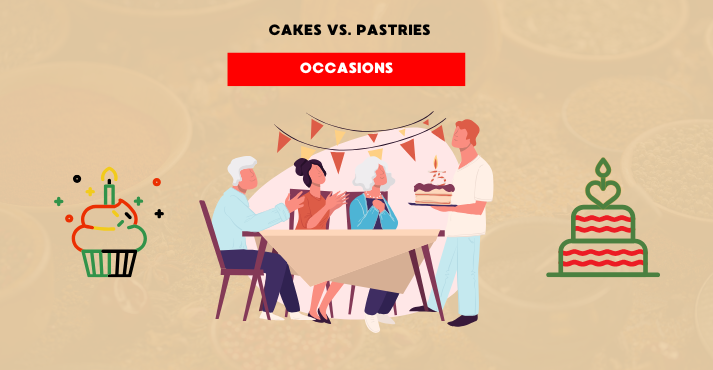
This factor is a by-product of their size that sets cakes and pastries apart in terms of where and when to enjoy.
Cakes
Cakes are closely associated with celebrations. Cakes are a standard centerpiece at events, whether a birthday, wedding, anniversary, or holiday gathering.
They are often decorated with candles, icing, and personalized messages to suit the occasion (thanks to their colossal surface area to play with customization).
Happiness increases if shared. In almost all modern cultures, cake cutting is a traditional part of celebrations that reflects shared happiness and enhances the memorable moments among friends, family, and loved ones.
Pastries
Pastries, on the other hand, are more commonly enjoyed as everyday snacks or desserts. They are often eaten as a quick breakfast item, with options like croissants and danishes being popular morning choices. Pastries are also found in bakeries and cafes, where they can be enjoyed with coffee or tea.
While pastries can be included in special events as desserts or opening treats, they are more frequently consumed casually throughout the day.
Similarities Between Cakes and Pastries
Cakes and pastries are popular baked goods that share several similarities despite their differences in texture and preparation. Both are made using core ingredients such as flour, sugar, eggs, and butter, making them sweet treats enjoyed in various settings.
While cakes and pastries may seem similar at first glance, they are crafted differently in French bakery traditions — learn more about the differences between a boulangerie and a pâtisserie in our guide.
One of the most fundamental similarities between cakes and pastries is their baking process. Both are prepared by combining ingredients into a dough or batter, which is then baked in an oven.
While cakes rely on leavening agents like baking powder to rise and become fluffy, pastries achieve their distinct texture through layering and butter content.
Moreover, both cakes and pastries come in various flavors and styles. Whether chocolate, vanilla, fruit-filled, or custard-based, both offer diverse tastes, look and feel. They are often served as desserts, snacks, or special treats at celebrations and gatherings.
Conclusion
After exploring all the key differences between cakes vs. pastries, you now know which one to choose and when to go between pastries or cakes.
Despite their textural and structural differences, cakes and pastries remain two of the most beloved baked items worldwide, offering various flavors, designs, and variations that appeal to different tastes and preferences.

